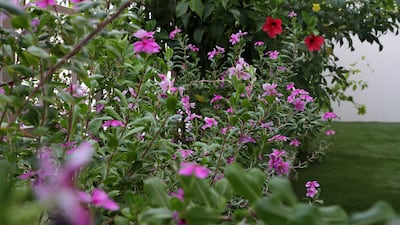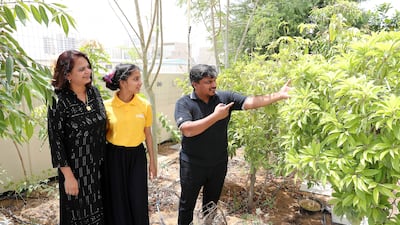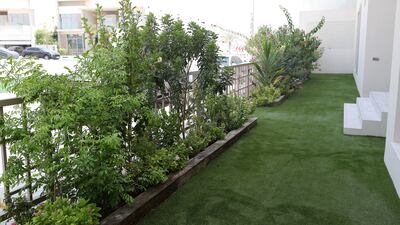Indian businessman Chandra Dake and his wife, Sujatha, are growing a veritable forest in their Al Furjan home in Dubai.
The temperature may be 40°C and more, but the plants that line the front of the Dake house, including a temple tree, jasmine, a coconut tree, roses and six varieties of hibiscus, are in full bloom. “These plants don’t grow in the desert normally, but here they are, flowering,” says Sujatha.
The back garden, meanwhile, doubles as an orchard and includes some trees that grow only in the tropics. In a year or so, the grapes, pomegranate, star fruit, moringa, papaya and other exotics will start to blossom, says Sujatha.

Dake, who moved from South Africa to the UAE in 2018, credits the flourishing space to “breathable sand” technology, aka Rechsand, from China, which he says has the power to revolutionise farming in the desert.
A product resulting from a collaboration between South Africa’s Dake Group and the Rechsand Technology Group from China, Rechsand is manufactured from the finest sand taken from the Gobi Desert and turned into a series of products, including pots and blankets that connect the ground air while retaining water to prevent seepage.

The process is patented and the sand has been treated to give it selective permeability. “We are able to choose which elements can pass through and which can be restricted,” says Dake. “The process of manufacturing is expensive because of the custom-built machinery that treats every molecular structure of the sand and the water through a rigorous process."
That said, a centimetre of bottom layering of Rechsand is enough to last a lifetime. Another upside to using this technology is the sustainability aspect, says Dake. Water consumption in gardening or farming is reduced by up to 80 per cent as a result, he says.
Dake brought the sand with him to the UAE. “We water the front of the house for two minutes in a day and the back garden for four minutes, and the total water bill we pay for using 13,000 gallons is Dh800 ($217) a month, which also includes home and swimming pool usage,” he says.

Air permeability is key
Dake says, recalling an experiment of sorts that he carried out in his office during the stay-at-home months last year: “We filled the office plants to the brim with water and when we reopened the office after two months, the plants were distressed, but not dead.”
The principle behind this technology is called surface-free energy, which is based on how solids react to the surface tension of liquids. Products based on similar technologies, such as hydrophobic sand, are already being used in the UAE. “When you pour water on hydrophobic desert sand, it repels the water, which is a technology called slacking,” Dake explains.

Though Rechsand has some similar properties to hydrophobic sand, the difference lies in the former’s breathability. “Air permeability is our speciality, because of which plant roots do better in terms of quality and growth,” he says.
Desert farming improved
Dake cites Rechsand's ability to enable rice farming on 607 hectares in a desert with a temperature of 57°C in inner Mongolia, a success story he also shared at the United Nations Convention to Combat Desertification in 2019.
The company is also working on a 4,500-kilometre green wall in China, of which 2,000km of forest has already been planted to improve vegetation in the desert.
“This technology is sustainable in large-scale desert farming and forest plantation settings because it conserves water and also gives greenery,” he says.

In the UAE, the company has worked with private farms and a few schools in Dubai via the Ministry of Education, and it provides landscaping services for villas. In Abu Dhabi, the technology has helped with the growing of peanuts, mung beans and black-eyed peas on some farms, while mango and lemon orchids have also shown fruitful results in 18 months, he says. The sand is likely to be introduced into hypermarkets for individual use, too.
Planting one tree with Rechsand costs between Dh200 and Dh250. “The recovery cost of each tree can be covered in less than one year if compared to the amount of water – between 2,000 and 2,500 gallons – it saves,” says Dake. Despite using less water, you can make green covers and long tracks with this sand, as opposed to, say, a greenhouse, which is hydroponic and cannot cover a lot of greenery.
The company is currently offering two projects to corporate clients: a perennial fruit forest and the Miyawaki forest. The latter is a Japanese design that grows 10 times faster. The Rechsand-Miyawaki combination, says Dake, has the potential to “make a lush green rainforest in the desert with very little water and trees that grow thicker, faster and taller”.








